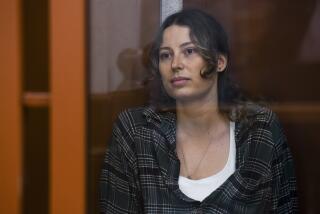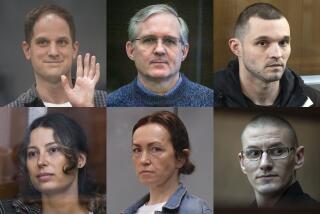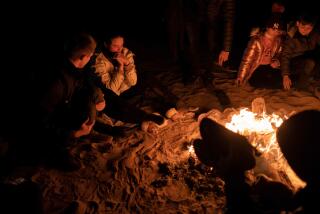Russian Brain Drain Flows Directly Into U.S. Science Talent Reservoir : Immigrants: Highly educated Russians are moving into top positions at prestigious universities and laboratories. They are revitalizing research and helping solve a multitude of perplexing problems.
- Share via
NEW YORK — Career counselor Stephen Rosen’s class rosters read more like a Who’s Who in Science than a list of newly arrived Russian immigrants looking for work.
Among his students, some of whom hold two doctorates, are physicians, lawyers, engineers, physicists, computer programmers and mathematicians.
They’re just a sampling of the talent that has poured into the United States in the past few years through the Russian “brain drain.”
“There is a great tradition of innovation and accomplishment that comes from the former Soviet Union,” said Rosen, a theoretical physicist.
Through his Scientific Career Transitions Program at the Workmen’s Circle, a Jewish fraternal organization in New York City, Rosen has helped more than 500 professionals, mostly Russian Jews, find jobs.
Across the United States, highly educated Russian immigrants are moving into top positions at prestigious universities and laboratories. They are revitalizing research and helping solve some problems that have stumped American scientists for years.
According to the U.S. Immigration and Naturalization Service, 218,561 citizens of the former Soviet Union legally immigrated to the United States between 1983 and 1993. The INS estimates that an additional 9,000 entered illegally.
“If you go around the Harvard campus, Russian is the second language. The same is true for the University of California at Berkeley and some other universities,” said Ronald Graham, adjunct director of research at AT&T; Bell Laboratories in Murray Hill, N.J.
“You can’t go to a science meeting without hearing Russian being spoken in many corners,” said Adrian Parsegian, acting chief of the structural biology laboratory at the National Institutes of Health in Bethesda, Md.
Parsegian has recruited several Russians whose backgrounds in physics and chemistry have helped American biologists better understand the forces that control living cells.
Russians make up the fastest-growing legal immigrant population in the United States. Since the Soviet Union collapsed in 1991, more new arrivals have come from Russia than from anywhere else except China, the Philippines and Vietnam.
In New York City, 90% of all refugees receiving welfare are Russian, says Marjorie Valleau of the Office of Human Resources.
Most of the former Soviet citizens are professionals, said Roald Hoffmann, a Nobel laureate and chemistry professor at Cornell University. “Many of them have entered the mainstream of science. Their children have become some of our best graduate students.”
But many others, he added, are driving taxis in New York.
“If a scientist emigrates to America and keeps working in his field, he is not a loss,” said Harley Balzer of Georgetown University, in Washington, D.C., an authority on Russian science and technology. “But if a scientist leaves his job and starts selling ice cream in a kiosk, he is a loss.”
Aleksandr Kaplan’s loss was brief. When he left Moscow 15 years ago, Kaplan worked nights in a Boston bookbindery for $4 an hour so that he could do unpaid research during the day at the Massachusetts Institute of Technology. Six weeks later, he landed his first research grant.
Now Kaplan, a professor of electrical engineering at Johns Hopkins University, runs a computer bulletin board for Russian job-seekers called “Info-Russ.” Nearly 1,000 emigres have access to its network data.
“All the world is flooded with Russian scientists trying to find work,” Kaplan said.
Sometimes climate favors the Russians. “We have trouble filling spots with Americans,” said Marvin L. Marshak, head of the School of Physics and Astronomy at the University of Minnesota. “They think Minnesota is too cold, too snowy. But Russians aren’t afraid of that.”
Stephen Rosen says that some U.S. companies are replacing well-paid professionals with Russian emigres who are willing to work for less. “Instead of paying an executive $90,000 a year, a company hires three Russians at $30,000 and gets the work of four people,” he said.
This may be causing some anxiety in the workplace.
“In this country nobody feels secure, and that’s one of the reasons for progress,” said Mikhail Sitkovsky, a biochemist-immunologist who is doing AIDS research at the National Institutes of Health.
Roald Sagdeev, a former head of the Soviet space program who is now a physics professor at the University of Maryland, says Russian scientists have brought with them “a luggage of experience and a culture of a different kind.”
That experience includes not only having passed rigorous examinations in the basic sciences, but also having developed the tenacity and political savvy to survive in the Soviet system.
And the Russians learned how to perform intricate calculations without benefit of the sophisticated computers available to their American counterparts.
This synthesis of Russian brainpower and American technology is leading to new approaches to problem-solving, especially in physics and mathematics.
“We’ve seen virtually a collapse of the mathematics culture in the former Soviet Union because so many left,” said Arthur Jaffe, a Harvard mathematics professor. “The United States certainly benefited from this enormously when we tapped the major talent.”
According to a Georgetown University study, the former Soviet Union produced roughly 25% of the world’s scientific workers and 50% of its engineers.
But the U.S. market for Russian talent is becoming saturated, and some educated immigrants are being forced to make career changes.
One of them is Alla Raykin, 45, who came to New York with her husband, son and six suitcases, half of them bursting with books and kitchenware.
Despite her Soviet doctorate in technology and years of experience as a computer programmer in a clothing factory, she had to settle for selling life insurance. She since has been promoted to sales manager.
As a reminder of home, Raykin has kept the Russian pots and pans.
More to Read
Sign up for Essential California
The most important California stories and recommendations in your inbox every morning.
You may occasionally receive promotional content from the Los Angeles Times.










